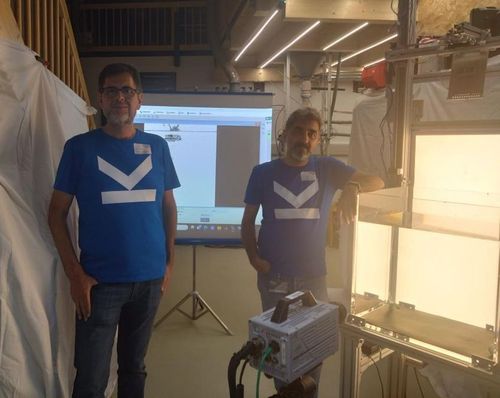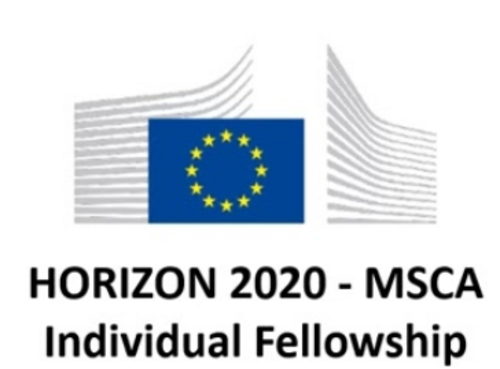Parallel Water Entry of Hydrophilic/Hydrophobic Projectiles: Experimental and Theoretical Aspects
A HORIZON 2020 - MSCA Individual Fellowship project funded by the European Union
This MSCA-project studied the side-by-side water entry of spheres with different coatings and sizes, both experimentally and theoretically. High-speed camera (HSC) imaging and Particle Image Velocimetry (PIV) measurements were used to examine phenomena, such as cavity development, sphere interaction, flow field details, etc.
The project was conducted by Pooria Akbarzadeh, who is an Associate Professor from the Shahrood University of Technology (SUT) in Iran. The fellowship was carried out at the host institution, the Institute of Fluid Mechanics and Heat Transfer at the Johannes Kepler University (JKU) Linz in Austria.
Project runtime: 1 August 2022 – 31 July 2024
Experimental Setup
Water Tank and Release Mechanism
The experiments were accomplished by utilizing a water tank (cross section of 50cm x 50cm) filled with demineralized water. A horizontal beam, that is adjustable in height supports the release mechanism. This allowed the release height to be varied from 15cm to 95cm. To ensure that two spheres could simultaneously be released at a defined lateral distance, a metallic plate with small carefully drilled holes is used. This plate is held in a horizontal position by an electromagnet. Upon deactivation of the electromagnet, a compressed spring forcefully and rapidly pushes down the plate, and the spheres descend towards the water surface. A priori tests demonstrated that the steel spheres do not experience any rotation and impact the water at the same time.
Spheres and Coating
Steel spheres with a diameter of 20mm and 12mm were used for the experiments. Without any coating, the spheres are hydrophilic (static contact angle of 85°), causing hardly any air entrainment upon water entry. Some of the spheres were coated with a superhydrophobic coating, which increased the static contact angle to over 165°. This causes a large air cavity to form behind the spheres upon water entry.
 Test rig for water entry tests
Test rig for water entry tests
High Speed Camera Imaging
Water entry events were recorded using two different High Speed Cameras:
- Photron FASTCam-SA3 (2000 fps, 1024x1024 pixels) used for close-up recordings to capture intricacies of the air cavity development, the splash dome development, etc.
- Kron Technologies CHRONOS-2.1HD (1512 fps, 1280x1024 pixels) used for wide area recordings to capture the sphere trajectories.
Particle Image Velocimetry
Particle Image Velocimetry was applied to obtain two-dimensional velocity fields of the water in the vicinity of the spheres. Fluorescent tracer particles were added to the flow and illuminated by a 2.0 Watt Continuous Wave green laser and tracked by a High-Speed Camera. All tank walls, except for the front wall, were covered by black matte sheets. An inclined mirror was used to reflect the laser sheet back to the area of interest. With this setup, it was possible to reduce unwanted reflections and to obtain an adequately illuminated area around the spheres. Lens filters were also used to improve the quality of the recorded particle images.
 Velocity vectors and streamlines from PIV
Velocity vectors and streamlines from PIV
Parallel Water Entry of Two Hydrophobic Spheres
Parallel water entry of two equally sized hydrophobic spheres produces air cavity patterns which are symmetric about the mid-vertical plane between the spheres. At large lateral sphere distances (distance to diameter ratio l/D=5) the cavities strongly resemble those of single water entry scenarios. When the lateral distance is reduced, the cavities are increasingly influenced by the neighboring sphere and cavity. At a distance-to-diameter ratio l/D=4 (sphere diameter D=20mm, release height above water surface 65cm) the video below shows significant deviations from the axisymmetry of the two air cavities.
When the sphere distance is reduced even further, an intriguing phenomenon can be observed. When the air cavity separates into an upper and lower part (cavity pinch-off), an air-tube forms, connecting the two parts. The formation of this tube can be attributed to non-axisymmetric velocity- and pressure distributions around the cavity. The video below shows the formation of this air tube for a distance-to-diameter ratio l/D=2 (sphere diameter D=20mm, release height 65cm).
Parallel Water Entry of Hydrophobic/Hydrophilic Spheres of Equal Size
Parallel water entry scenarios using spheres of equal size, but different surface wettability (one hydrophilic, one hydrophobic) show several interesting phenomena. The flow around the hydrophilic sphere is non-axisymmetric, which leads to asymmetrical vortex-shedding behind the sphere. This can lead to a second pinch-off event of the cavity behind the hydrophobic sphere. This is demonstrated in the video below (sphere diameter 20mm, release height 45cm, lateral sphere distance l/D=1.5). In addition, the trajectory of the hydrophilic sphere is strongly influenced, and it experiences strong deviations from a vertical path.
If a hydrophilic and a hydrophobic sphere enter the water at a very small lateral distance, another intriguing phenomenon can be observed. As demonstrated by the video below, after the initial entry event, an air cavity can attach to the hydrophilic sphere and remain attached as the sphere moves further downwards.
Parallel Water Entry of Hydrophobic/Hydrophilic Spheres of Different Sizes
Parallel water entry scenarios of spheres of different wettabilities (hydrophilic and hydrophobic) and different sphere diameters show several interesting features. The trajectories of the spheres can be strongly influenced, the cavity behind the hydrophobic sphere can show strong distortions, and the vortex shedding behind a small hydrophilic sphere can also cause a second pinch-off event of the cavity behind the hydrophobic spheres. The two videos below show two spheres of 12mm and 20mm diameter and different wettabilities released from a height of 45cm above the water surface.
Scientific Publications
Results of High-Speed Camera Investigations of Parallel Water Entry were published in the following article
WE-Experth at Lange Nacht der Forschung
On 24 May 2024 the 'Lange Nacht der Forschung' (Long Night of Research), an event dedicated to presenting science and research to the public, took place at approximately 270 exhibition venues and 2800 stations across Austria. We took this opportunity to demonstrate and explain the events associated with water entry and the underlying physical phenomena by performing live High-Speed Camera measurements. Visitors could choose between different objects, ranging from differently coated steel spheres to simplified bird models for performing these water entry tests. Differences in cavity entrainment, trajectory stability and splash development could be investigated on the spot and compared and discussed in detail. Thanks to the HSC recordings, we could replay the results for the audience if requested. The event drew a large number of visitors of all ages and backgrounds and was a huge success.
 WE-Experth test rig at 'Lange Nacht der Forschung'
WE-Experth test rig at 'Lange Nacht der Forschung'
This project has received funding from the European Union’s Horizon 2020 research and innovation programme under the Marie Skłodowska-Curie grant agreement No 101022112

 Zur JKU Startseite
Zur JKU Startseite


